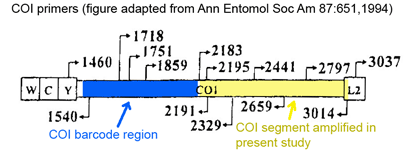New York Times columnist John Tierney publishes an article “Use Energy, Get Rich and Save the Planetâ€Â about the PHE work on whether Richer is Greener.
Blog
The Jack Rabbit of Depression, or Do economic slumps benefit environment?
Some wonder whether the present economic slump will elicit a change of direction and faster progress in reducing environmental harm. Jesse Ausubel and Paul Waggoner, assisted by Smriti Rao, examined what happened to USA energy use and emissions during the slumps of the 1930s and after World War II.  A short essay, “The Jack Rabbit of Depression, or Do economic slumps benefit environment?†provides our answer. Two 40-second animations prepared by Smriti show the year-by-year changes from 1920 to 1940 of energy intensity and carbon emissions.
Keeping a steady course rather than darting about was also a theme of Jesse’s address “Natural Gas and the Jack Rabbit†to the Power South Energy Cooperative on 22 January 2009.
Rise and Fall of SO2 emissions in USA
We post the rise and fall of sulfur dioxide emissions in the USA, which form an Environmental Kuznets Curve where richer is first dirtier and then richer becomes cleaner, as explored in the 3/12/09 posting about “Is Richer Greener“?
Dinoflagellate diversity revealed by DNA
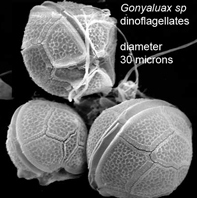 Peering into the vast diversity of life beyond multicellular eukaryotes (animals, plants, and fungi) is dizzying. In March 2009 Applied Environ Microbiol researchers from University of Connecticut assess dinoflagellate diversity with mitochondrial DNA sequencing. Dinoflagellates are unicellular, often photosynthetic, mostly marine plankton characteristically having two flagella and encased in a segmented hardened exterior. Dinoflagellate blooms are the cause of red tides, and dinoflagellate toxins ingested by fish and shellfish are the cause of ciguatera and paralytic shellfish poisoning. For unknown reasons, some species are bioluminescent when mechanically stimulated, producing glowing displays when perturbed by waves, fish, or kayakers, for example.
Peering into the vast diversity of life beyond multicellular eukaryotes (animals, plants, and fungi) is dizzying. In March 2009 Applied Environ Microbiol researchers from University of Connecticut assess dinoflagellate diversity with mitochondrial DNA sequencing. Dinoflagellates are unicellular, often photosynthetic, mostly marine plankton characteristically having two flagella and encased in a segmented hardened exterior. Dinoflagellate blooms are the cause of red tides, and dinoflagellate toxins ingested by fish and shellfish are the cause of ciguatera and paralytic shellfish poisoning. For unknown reasons, some species are bioluminescent when mechanically stimulated, producing glowing displays when perturbed by waves, fish, or kayakers, for example.
As a first step toward creating a reference library, Lin and colleagues compiled mtDNA sequences from 49 dinoflagellate species representing six orders (this included 20 COI and 60 cytochrome b sequences; 12 of the latter were newly obtained in this study). As there are about 2500 named dinoflagellate species, this is a sparsely-populated reference library so far. In addition, there were multiple samples from just 5 species, so intraspecific variation is not yet well-studied. As an aside, I note that most of the published and new sequences were derived from strains maintained at Pravasoli-Guillard National Center for Culture of Marine Phytoplankton (CCMP). There is no explicit mention of CCMP in the paper or GenBank depositions, although a plankton specialist would probably recognize the source from sample designations. More generally, there is no formal documentation of taxonomic identifications (eg collection sources for cultures or photographs for environmental samples and/or individual who performed identifications). Although this is not unusual in taxonomic papers, it seems to me that identifications should be as well documented as for example PCR conditions.
In preparing the reference library, the researchers were unable to develop primers that amplified the barcode region of COI efficiently (ie the primers worked with some species and not others) and instead focused on cytochrome b using a primer pair that amplified a 385 bp segment. The primer difficulty is surprising given that COI is usually more conserved than cyt b (including in dinoflagellates), which should make it easier to design broad-range primers. 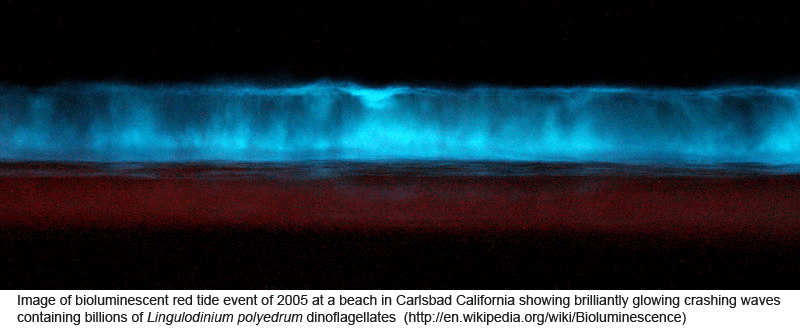
The researchers then analyzed pooled environmental DNA samples prepared by filtering water specimens collected during different months at 3 marine stations in Long Island Sound and at a freshwater retention pond (Mirror Lake) on the University of Connecticut campus. While PCR products from monospecific cultures were sequenced directly, those from environmental samples were first cloned, and then 20 to 50 clones from each water sample were sequenced (total clones analyzed 450).
Lin and co-workers obtained a large number of distinct haplotypes from the environmental samples; by my inspection of their phylogram nearly all of the clones (>420) were unique. Only a small minority could be assigned to known species or genera. On the technical side, the authors used a complex model of nucleotide substitution (TVM+G) to calculate differences among haplotypes and UPGMA to create trees, so their distance results and trees are not directly comparable to those in most DNA barcoding papers, which use K2P- or p-distances to calculate differences and neighbor-joining to create trees. In any case, according to the authors, the sequence results consistently showed greater diversity than was detected through microscopic analysis, “likely caused by the much higher detection sensitivity of PCR than of microscopic counting and by some genotypes that could not be discriminated morphologically.” The authors conclude “[w]hen a broader cob [cyt b] database becomes available, the taxon-resolving power of this gene would certainly increase.” I hope they or others will also develop efficient primer sets for amplifying COI in addition to cyt b.
Looking ahead, the reference library can be augmented relatively inexpensively by analyzing mtDNA sequences of the 2400 strains at CCMP. However, the mtDNA diversity in this study suggests dozens of new species from just 4 sampling sites around Connecticut, implying the global total of undescribed species is very large. This suggests a need for some sort of “automated species identifier”: a machine approach that would sort samples into individual cells, then photograph, sequence, apply MOTU-type analysis, for example. In the meantime, it may be necessary to work with pooled sequences from environmental samples, as is done for bacterial communities, without attempting to delineate species.
Sushi-gate in SOI Magazine
PHE-sponsored “Sushi-gate†investigation is featured in April 2009 Scripps Oceanographic Institute Magazine. The article, which describes work done by FISHBOL researchers Phil Hastings and Ron Burton, quotes PHE’s Mark Stoeckle and cites his daughter Kate, co-author with her high school classmate Louisa Strauss, of 2008 report on mislabeled fish sold in NYC revealed by DNA barcoding (aka “Sushi-gateâ€).
DNA sorts out bewildering morphology
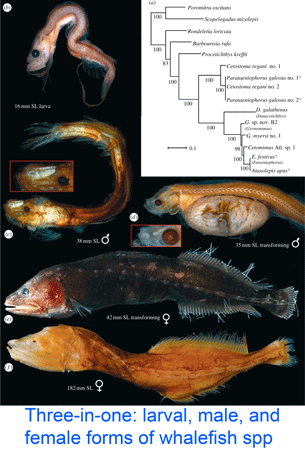 DNA helps flag genetically divergent forms that may represent cryptic species and is equally valuable the other way around: in linking morphologically diverse forms that occur within species. In 20 jan 2009 Biol Lett, researchers from National Museum of Natural History, Washington, DC; Australian Museum, Sydney; Virginia Institute of Marine Science; University of Tokyo; and Natural History Museum, Tokyo, solve the mystery of “the most extreme example of ontogenetic morphoses and sexual dimorphism in vertebrates.”
DNA helps flag genetically divergent forms that may represent cryptic species and is equally valuable the other way around: in linking morphologically diverse forms that occur within species. In 20 jan 2009 Biol Lett, researchers from National Museum of Natural History, Washington, DC; Australian Museum, Sydney; Virginia Institute of Marine Science; University of Tokyo; and Natural History Museum, Tokyo, solve the mystery of “the most extreme example of ontogenetic morphoses and sexual dimorphism in vertebrates.”
Johnson and colleagues examined specimens of small (body size 4-408 mm) deep water (1000-4000m) fishes thought to represent 3 families in the order Stephanoberyciformes (whalefish and relatives). The authors analyzed morphology and whole mitochondrial genomes from 34 individuals of 16 species including representatives of all 5 whalefish families. They found three whalefish “families” are one: “Mirapinnidae (tapetails), Megalomycteridae (bignose fishes), and Cetomimidae (whalefishes), are larvae, males and females, respectively of a single family Cetomimidae.” These are strange-looking fish–the males, which do not feed as adults, are sustained by enormous livers, and the minute larvae have streamers up to 75 cm. For fun, see deep ocean video of live female whalefish swimming (and narration of the amazed icthyologists) in supplementary material. Next up is to link the three life stages of each species; here DNA will help along with meristic data (quantitative features such as number of fins or scales).
Why do mitochondria differ among species?
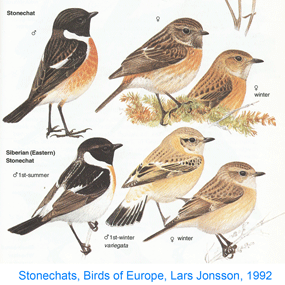 Mitochondria are the power plants of the cell, consuming oxygen and breakdown products of sugars, amino acids, and fatty acids to produce energy as ATP and heat. As originally proposed by Lynn Margulis in 1967, mitochondria, which have their own circular genome and replicate independently of the cell, are derived from an ancient symbiosis of an an alpha-proteobacterium related to gram-negative bacteria.
Mitochondria are the power plants of the cell, consuming oxygen and breakdown products of sugars, amino acids, and fatty acids to produce energy as ATP and heat. As originally proposed by Lynn Margulis in 1967, mitochondria, which have their own circular genome and replicate independently of the cell, are derived from an ancient symbiosis of an an alpha-proteobacterium related to gram-negative bacteria.
In multicellular animals, most of the 100+ proteins in mitochondria are encoded by nuclear genes. The mitochondrial genome is only about 16 kb (vs about 2000 kb for nearest bacterial relatives Rickettsia sp) and encodes just 13 proteins, all of which function in the electron transport chain, plus 2 ribosomal RNAs and approximately 20 tRNAs. Multiple protein-protein interactions (for example, complex I comprises 34 nuclear-encoded and 7 mitochondrial-encoded proteins) suggest there must be close co-evolution between nuclear and mitochondrial genomes; this might be one of the constraints on mitochondrial variation. Although an enormous amount of information on mitochondrial sequence differences among and within species has been been compiled (through DNA barcoding initiative and other efforts), there is surprisingly little study so far on whether mitochondrial differences among species reflect functional adaptation (although see Ruiz-Pesini et al 2004 Science 303:223, Bayona-Balfaluy et al 2004 Mol Biol Evol 22:716).
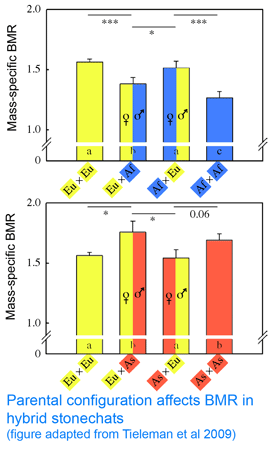 In 25 February 2009 Proc R Soc B researchers from University of Groningen, The Netherlands; Max Planck Institute for Ornithology, Germany; and Ohio State University investigate whether mitochondrial differences modulate energy metabolism in birds. As mitochondria consume 90% of respired oxygen, mitochondrial activity presumably determines basal metabolism. Tieleman and colleagues performed crosses among 3 captive bred populations of stonechats (Saxicola torquata spp.) that differ in basal metabolic rate, which presumably reflects adaptation to different climates: Africa (Kenya, Saxicola torquata axillaris), Asia (Kazakhstan, Saxicola torquata maura), and Europe (Austria, Saxicola torquata rubicola). As an aside, I note that these three taxa are elevated to species status in current world checklists (Clements 2007, IOC Checklist; even 1992 edition of Birds of Europe notes “Siberian race may be a full species.”) This does not change the interpretation of the findings, but it does reflect the confused nature of taxonomic science that even for a group as well studied as birds, publication standards accept this laxity in taxonomic classification. Naming of bacteria in medical studies is more uniformly up to date than for multicellular animals; it seems that animal taxonomists have not found a way to establish a regularly updated consensus. In this regard the IOC Checklist suggests a way forward: “in this global world of wiki-style sharing of knowledge, we invite world birders and ornithologsts alike to help us keep the IOC list accurate, vital, and accessible.”
In 25 February 2009 Proc R Soc B researchers from University of Groningen, The Netherlands; Max Planck Institute for Ornithology, Germany; and Ohio State University investigate whether mitochondrial differences modulate energy metabolism in birds. As mitochondria consume 90% of respired oxygen, mitochondrial activity presumably determines basal metabolism. Tieleman and colleagues performed crosses among 3 captive bred populations of stonechats (Saxicola torquata spp.) that differ in basal metabolic rate, which presumably reflects adaptation to different climates: Africa (Kenya, Saxicola torquata axillaris), Asia (Kazakhstan, Saxicola torquata maura), and Europe (Austria, Saxicola torquata rubicola). As an aside, I note that these three taxa are elevated to species status in current world checklists (Clements 2007, IOC Checklist; even 1992 edition of Birds of Europe notes “Siberian race may be a full species.”) This does not change the interpretation of the findings, but it does reflect the confused nature of taxonomic science that even for a group as well studied as birds, publication standards accept this laxity in taxonomic classification. Naming of bacteria in medical studies is more uniformly up to date than for multicellular animals; it seems that animal taxonomists have not found a way to establish a regularly updated consensus. In this regard the IOC Checklist suggests a way forward: “in this global world of wiki-style sharing of knowledge, we invite world birders and ornithologsts alike to help us keep the IOC list accurate, vital, and accessible.”
Back to the paper. Tieleman and colleagues “tested for a genetic effect on BMR based on mitochondrial-nuclear coadaptation using hybrids between ancestral populations with high and low BMR (Europe-Africa and Asia-Europe), with different parental configurations (female-high x male-low or female-low x male-high). Hybrids with different parental configurations have on average identical mixtures of nuclear DNA, but differ in mitochondrial DNA because it is inherited only from the mother.” The researchers found that metabolic rate differed between hybrids with contrasting parental configurations, “providing evidence for the importance of a match between mitochondrial and nuclear genomes to regulate metabolic rate.” So far so good. However, contrary to expectations, in both sets of crosses, metabolic rates in hybrids were more similar to that of the father than the mother! (see adapted figure). This result is a puzzler; it suggests there might be another factor such as genomic imprinting at work.
Looking at the bigger picture, for those interested in mitochondrial evolution, there is a lot of opportunity: a large and growing database of COI sequences (>500,000 individuals, >50,000 species so far) that is waiting to be analyzed for evidence of purifying or positive selection, for example, or for limits to plasticity in COI amino acid sequence. I wonder if there might be convergent evolution of COI, such that diverse organisms in very cold or very hot environments environments, for example, might exhibit similar amino acid substitutions.
NAP books from 1983 (Thanks, Google).
Thanks to scanning by Google Books, we post two vintage reports for which Jesse early in his career was the lead scribe: Changing Climate, Report of the Carbon Dioxide Assessment Committee, National Research Council, Washington DC , 1983. Toward an International Geosphere-Biosphere Program: A Study of Global Change, National Research Council, Washington DC , 1983.
“Changing Climate†was the first comprehensive review of the now popular global warming issue, while “Toward an IGBP†defined what became the Global Change Research Program.
DNA analysis helps unravel food webs
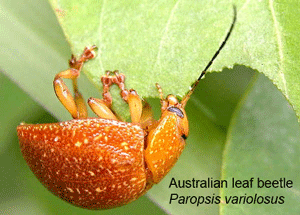 What do leaf beetles (Chrysomelidae) eat? In 11 Nov 2008 Proc R Soc B researchers from Spain, London, and Australia, apply DNA analysis to 76 species (1 individual/species) of Australian leaf beetles. Jurado-Rivera and colleagues extracted DNA from whole beetles using DNAeasy kit. To identify plant DNA in beetle extracts, they amplified chloroplast trnL intron (313 to 581 bp in analyzed samples). 70 (92%) of samples gave high quality reads after direct sequencing of the PCR products, consistent with ingestion of a single plant species; the remaining samples were sequenced from cloned PCR products; these gave 2 divergent clones in 3 of seven cases, for a total of 81 different trnL intron sequences. Why use trnL intron? The authors cite the large number of sequences in GenBank and favorable experience (ie successful amplification and good taxonomic resolution) in their prior work and that of others (eg Taberlet et al 2007 Nucleic Acids Res 35:e14). This certainly makes sense, but I hope a general agreement for plant barcode standards will be published shortly, otherwise the field will continue to be hobbled by having multiple incomplete and non-overlapping databases for the various markers. For example, according to the authors “only 14 and 15 of approximately 1000 and 800 described Australian species of Acacia and Eucalyptus, respectively, are represented in GenBank by trnL intron sequences. As to what resolution is possible with current trnL database, the authors found “reliable identification to plant family in every case and very frequently the inference is possible at lower taxonomic levels.”
What do leaf beetles (Chrysomelidae) eat? In 11 Nov 2008 Proc R Soc B researchers from Spain, London, and Australia, apply DNA analysis to 76 species (1 individual/species) of Australian leaf beetles. Jurado-Rivera and colleagues extracted DNA from whole beetles using DNAeasy kit. To identify plant DNA in beetle extracts, they amplified chloroplast trnL intron (313 to 581 bp in analyzed samples). 70 (92%) of samples gave high quality reads after direct sequencing of the PCR products, consistent with ingestion of a single plant species; the remaining samples were sequenced from cloned PCR products; these gave 2 divergent clones in 3 of seven cases, for a total of 81 different trnL intron sequences. Why use trnL intron? The authors cite the large number of sequences in GenBank and favorable experience (ie successful amplification and good taxonomic resolution) in their prior work and that of others (eg Taberlet et al 2007 Nucleic Acids Res 35:e14). This certainly makes sense, but I hope a general agreement for plant barcode standards will be published shortly, otherwise the field will continue to be hobbled by having multiple incomplete and non-overlapping databases for the various markers. For example, according to the authors “only 14 and 15 of approximately 1000 and 800 described Australian species of Acacia and Eucalyptus, respectively, are represented in GenBank by trnL intron sequences. As to what resolution is possible with current trnL database, the authors found “reliable identification to plant family in every case and very frequently the inference is possible at lower taxonomic levels.”
There also needs to be an agreement to have a curated plant barcode database. As the authors report, “in the course of this study, we found several examples of erroneous taxonomic assignments (e.g. Sapindaceae identified as Cypripedium, Cypripedioideae; Apocynaceae labelled as Sesamum, Pedaliaceae; one case of names switched between Pittosporum and Cheiranthera, both Pittosporaceae; suspicious generic assignment for Aesculus x carnea), and of sequencing artefacts (e.g. Tragopogon spp., Acacia usumatensis) and chimeras (e.g.Pentaphylax euryoides). Problems introduced by these sequences were only apparent after careful inspection of trees revealing suspicious relationships, and required phylogenetic re-evaluation after removing problematic sequence data.”
This is helpful for the present study, but the problematic sequences remain in the reference databases, ready to trip up the next set of researchers who might not be so careful. To fix this problem, Jurado-Rivera and colleagues make what I think is the wrong suggestion, namely “all of the above would argue for the use of additional markers”. Adding markers may improve the ability to make species-level identifications in plants, but if the goal is to construct an error-free database, adding markers is an expensive and likely ineffective way to ferret out mislabeled or otherwise inaccurate sequences. What is needed is a stand-alone database, closely-linked to GenBank, in which problematic sequences can be weeded out or re-labeled (ie Barcode of Life Database (BOLD) www.barcodinglife.org).
To construct a beetle phylogeny, the authors amplified COI and EF1a from their specimens. They found strong concordance between the evolutionary histories of Australian Chrysomelinae beetles and their host plants, indicating long-term co-evolution. They conclude “our analysis not only shows the details of ecological associations for a dominant herbivore group but also offers the basis for their evolutionary interpretation.”
I am puzzled that the authors amplified a segment in the 3′ half of COI that does not overlap with the standard animal barcode region, making it impossible to combine their data with the 500,000+ COI sequences analyzed to date (www.barcodinglife.org). This important caveat aside, I look forward to many more studies that utilize DNA barcoding to join ecology and phylogenetics.
Joshua Lederberg
Great scientist and friend Joshua Lederberg passed away 2 February 2008. Josh recruited Jesse to The Rockefeller University in 1984, promoted him in 1989, and supported the formation of the Program for the Human Environment in 1993. Jesse was honored to offer recollections of Josh at his memorial service in February 2008 and a tribute to Josh’s foresight at the January 2009 Rockefeller symposium celebrating his contributions. The tribute highlights Josh’s astonishing anticipation in 1978 of the growth of email and the Internet.
